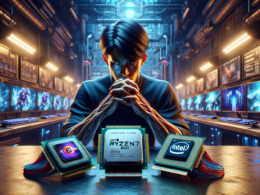In a groundbreaking shift within the handheld gaming community, modders are diligently working to integrate NVMe SSD technology into the newly released Nintendo Switch 2. This ambitious project, although still in its experimental stages, taps into the growing demand for faster and more expansive storage solutions in gaming consoles, particularly as games continue to increase in size and complexity.
Zooming In
The Technology Behind the Mod
The Nintendo Switch 2 supports the microSD Express slot, a notable upgrade over the previous models. This slot offers data transfer speeds significantly faster than its predecessors, paralleling the capabilities seen in PCIe slots used in computers. This enhancement has spurred modders to explore potential methods to harness NVMe SSD benefits, which are universally noted for their speed and efficiency.
NVMe (Non-Volatile Memory Express) technology operates over the PCIe bus, enabling faster data access speeds than traditional SATA SSDs, making it highly desirable for applications that require rapid data retrieval, such as high-definition gaming. By attempting to align the microSD Express slot of the Switch 2 with NVMe capabilities, modders aim to exponentially increase the console’s storage speed and capacity.
A Challenge Worth Tackling
James Bentley, a tech enthusiast and hardware writer, highlights the efforts of Better Gaming-a YouTube creator and innovator in hardware tinkering. Their attempt involved leveraging an open-source project by NVNT Labs, which sought to convert the microSD Express slot to support an M.2 connector compatible with NVMe SSDs. However, despite meticulous engineering efforts, including designing custom PCBs and precise soldering, initial attempts faced compatibility hurdles. The Switch 2, expecting a communication from its default microSD controller, failed to recognize the NVMe drive.
NVNT Labs has remained optimistic, suggesting future modifications could successfully simulate the necessary signals for NVMe recognition, marking a significant achievement in consoling hardware modification.
The Broader Implications
This pursuit of modifying the Nintendo Switch 2 is part of a larger conversation within the tech community about customizability and user empowerment in consumer electronics. Nintendo consoles are traditionally closed systems, often resisting modifications. Current industry trends lean towards offering users more control and custom options, as seen in companies like Valve with their Steam Deck, which offers easier mod support and customization capabilities.
From a business perspective, enabling-or at least not hindering-creative consumer modifications might bolster a product’s lifecycle and improve user satisfaction and loyalty. As gaming continues to evolve with more resource-demanding applications, consumers will consistently seek ways to enhance their experience, sometimes through unconventional methods.
Keeping an Eye on the Future
The efforts to integrate NVMe SSDs into the Nintendo Switch 2, despite challenges, reflect a profound demand for enhanced gaming experiences and the convergence of high-performance computing with portable devices. While mainstream adoption of such mods could still be on the horizon, these endeavors underscore the potential future capabilities of portable gaming platforms.
As advancements continue, it remains paramount for developers, hardware manufacturers, and the broader tech community to consider how emerging storage technologies can lead the next wave of gaming innovation. Enthusiasts and casual gamers alike watch with interest, as the boundaries of what is possible continue to expand and redefine the gaming landscape.









